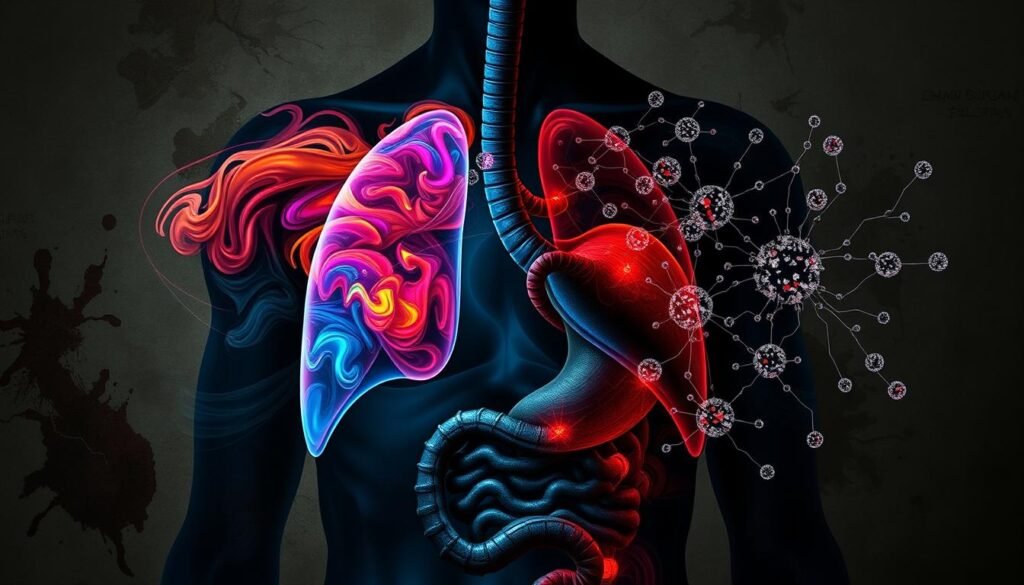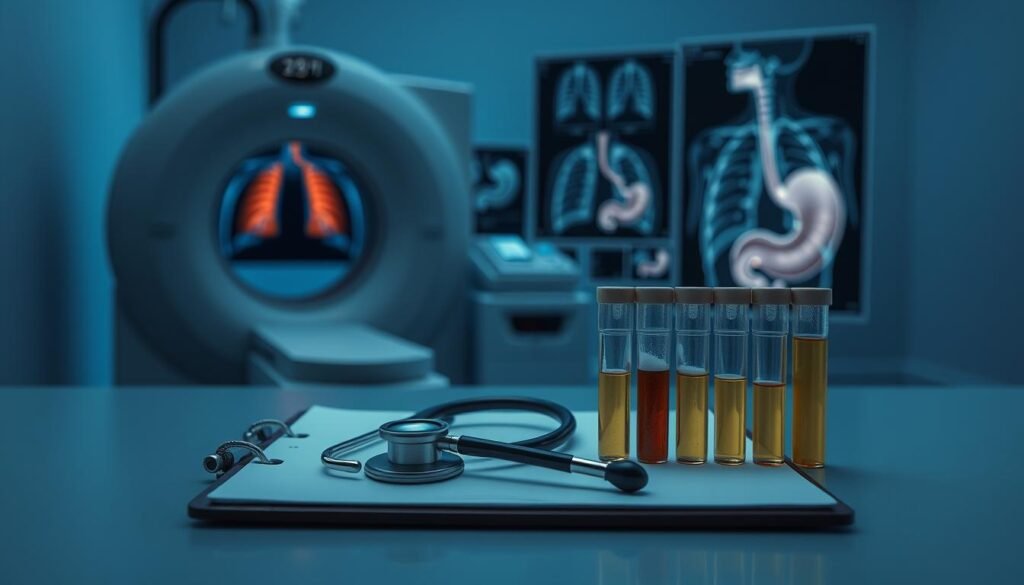Surprisingly, lung cancer was behind roughly 132,000 deaths in the United States in 2021. It accounted for 22 percent of all deaths from cancer. While mainly linked to breathing problems, there’s a lesser-known issue: can lung cancer lead to stomach pain? This piece looks into how lung cancer might cause belly aches. It highlights the not-so-obvious symptoms of lung cancer that show up in different ways as it gets worse.
It’s key to understand these connections because the spread of lung cancer can affect various parts of the body. Symptoms like abdominal pain may not seem related to the lungs at first. However, they can be a sign that the cancer is getting more serious. We’ll explore how this illness can lead to discomfort outside of the chest area.
Key Takeaways
- Lung cancer is linked to about 132,000 deaths every year in the US, showing its impact.
- Stomach pain could be a clue that lung cancer is growing, especially if it has spread.
- Some common lung cancer symptoms are cough, tiredness, and pain in different parts of the body.
- Noticing less common signs can help catch the disease early and start treatment sooner.
- Talks with doctors about symptoms should cover concerns about how far the cancer has spread.
Understanding Lung Cancer and Its Symptoms
Lung cancer often develops silently, without clear signs. Many patients don’t notice symptoms until the disease advances. Recognizing potential symptoms early is key for timely diagnosis and treatment. If you see unusual symptoms, see a doctor right away. Catching it early can greatly improve your chances.
Common Symptoms of Lung Cancer
Common symptoms include:
- Persistent cough or changes in an existing cough
- Chest pain or discomfort
- Coughing up blood or rust-colored sputum
- Shortness of breath or wheezing
- Fatigue or unexplained weight loss
- Recurring respiratory infections
- Hoarseness or difficulty swallowing
Some people might also have back or shoulder pain. Recognizing these symptoms is crucial. For more details, you can learn about lung cancer symptoms and what they mean.
Unexpected Signs of Lung Cancer
There are also less known symptoms, such as:
- Dizziness or frequent headaches
- Clubbing of the fingers
- Changes in vision or other neurological symptoms
About 25% of lung cancer patients report back pain. It shows the importance of being vigilant. Non-smokers are often misdiagnosed, leading to delays in treatment. Knowing these less obvious signs can help you react faster.
The Connection Between Lung Cancer and Abdominal Pain
Spotting abdominal pain in lung cancer victims is tricky. This discomfort might come from the tumor itself or nearby lymph nodes pressing down. If the lung has a tumor, it could squeeze other organs. This might cause pain to spread to the belly, making it vital for doctors to recognize this symptom.
Only 12% of lung cancer patients get gastrointestinal metastases. It’s more common in certain lung cancers like large cell carcinomas. Men around 64.5 years old are often diagnosed with these issues, making up 89% of these cases.
Knowing how lung cancer spreads is key to understanding why abdominal pain occurs. The jejunum is usually affected, with 53% of cases, followed by the ileum at 28%. Small cell carcinoma is behind about 19.6% of these cases. This knowledge helps doctors watch for complications from the cancer spreading.
After finding lung cancer, many patients report belly problems. For those with metastatic non-small cell lung cancer causing bowel perforation, survival is tough, at an average of 66 days. The small bowel is often where these risky issues occur, underscoring the importance of monitoring lung cancer patients closely.
The following table summarizes the prevalence of gastrointestinal complications in lung cancer patients:
| Study/Incidence | Percentage | Age at Diagnosis (Mean) | Survival Post-Diagnosis (Days) |
|---|---|---|---|
| Gastrointestinal Metastases from Lung Cancer | 12% | 64.5 years | 66 days |
| Large Cell Carcinomas | Higher Rate | N/A | N/A |
| Small Cell Carcinoma & Perforations | 19.6% | N/A | N/A |
| Perforations in Jejunum | 53% | N/A | N/A |
| Perforations in Ileum | 28% | N/A | N/A |
For more details on lung cancer’s unexpected signs, visit this informative source. A good understanding of how lung cancer can show up in various systems is crucial. It highlights the need for quick action and constant support for patients.
https://www.youtube.com/watch?v=ihCnDjyJv5c
Can Lung Cancer Cause Stomach Pain?
It’s key to know how lung cancer and stomach pain might be related. Often, lung cancer does not show symptoms early on. However, as it gets worse, it can cause symptoms like stomach pain. This is due to referred pain.
Mechanisms Behind Pain Transmission
Referred pain means feeling pain away from where it starts. In lung cancer, this can make your stomach hurt. This is because your brain gets mixed up about where the pain is coming from. So, can lung cancer cause stomach pain? Yes, because of how pain signals work.
Referred Pain and Its Implications
Referred pain can make it hard to diagnose lung cancer. As the cancer spreads, it might affect nearby areas, causing stomach pain. For instance, pleural effusion involves fluid around the lungs. This can press around and cause pain in the stomach. It shows why detailed exams are crucial for lung cancer patients with stomach pain.
How Lung Cancer Can Metastasize to Other Organs
Metastatic lung cancer is a severe step in lung cancer’s progress. It happens when cancer cells move beyond the lungs to other organs. Knowing about metastatic lung cancer helps patients and families understand treatment better. It also shows the importance of early detection.
What is Metastatic Lung Cancer?
Metastatic lung cancer begins when cancer cells spread from the lung to other body parts. This spread harms patient health, often causing pain and discomfort. About 30–40% of people with non-small cell lung cancer have metastasis at diagnosis. When cancer spreads, survival rates fall sharply, leaving only 9% likely to survive five years.
Sites of Metastases Associated with Lung Cancer
It’s crucial to know where lung cancer tends to spread. Common metastasis sites include:
| Organ | Percentage of Cases | Typical Symptoms |
|---|---|---|
| Liver | Varies | Stomach pain, jaundice |
| Bone | 35–40% | Bone pain, increased fracture risk |
| Brain | 40% | Headaches, seizures, neurological deficits |
| Gastrointestinal Tract | 7.3% to 12.2% | Abdominal pain, nausea, gastrointestinal bleeding |
Different sites of metastasis show unique symptoms and challenges. For instance, lung cancer spreading to the gastrointestinal tract can cause gastric metastasis in about 5.1% of cases. Patients might face chronic pain and anemia. To learn more, check this overview of common metastatic sites. Treatments focus on symptom management and life quality improvement.

Common Gastrointestinal Complications in Lung Cancer Patients
Lung cancer can cause many stomach problems, seriously affecting patients’ lives. Hypercalcemia is one common issue that leads to these problems. Knowing about these complications is key to managing them well.
Hypercalcemia and Its Effects on Stomach Issues
About 20% of lung cancer patients develop hypercalcemia. This condition means there’s too much calcium in the blood. It causes stomach issues like nausea, throwing up, and stomach pain. These problems can make cancer treatment harder and lower a patient’s quality of life.
Impact of Tumors on Gastrointestinal Function
Tumors can directly affect the stomach and intestines, leading to issues. These problems may include blocked bowels or other serious conditions. They can cause stomach pain or even bleeding. Even though these complications are rare, they need close attention. They often mean a worse outlook for the patient, making careful monitoring crucial.
Advanced Cancer Stages and Their Symptoms
When cancer reaches advanced stages, the symptoms become more severe. Knowing about these symptoms is crucial for proper care. This knowledge can help in making timely decisions that improve life quality.
Recognizing Late-Stage Symptoms
In the later stages of cancer, symptoms show the body fighting the disease. Patients might notice several common symptoms.
- Weight Loss: Significant muscle loss is seen in up to 80% of patients.
- Pain Management Challenges: About 25-50% of patients struggle to find relief from pain.
- Nausea and Vomiting: Chronic nausea affects 60-70% of patients in advanced stages.
- Skin Problems: Dry skin, itching, and fragility are common, often made worse by dehydration.
- Pressure Sores: These sores affect 25-30% of patients, especially those who can’t move much.
Importance of Early Detection
Noticing late-stage symptoms early can greatly help patients. Detecting these symptoms early can change treatment options and the overall outlook. Regular checks for people at risk can lead to early intervention. This helps manage both physical and emotional challenges of the disease.

Pleural Effusion and Its Role in Abdominal Pain
Pleural effusion happens when too much fluid gathers around the lungs. It’s usually caused by other diseases, like lung cancer. This can make life harder for those with it. Knowing how pleural effusion and abdominal pain are connected is important, especially for cancer patients.
What is Pleural Effusion?
Pleural effusion often starts because of health problems such as cancer, heart failure, or pneumonia. It can turn into malignant pleural effusion for patients with lung, mesothelioma, breast, or ovarian cancer. This fluid buildup can lead to trouble breathing and pain in the chest and belly areas.
Symptoms Associated with Pleural Effusion
People with pleural effusion usually experience:
- Shortness of breath
- Chest pain
- Coughing
- Swelling in the abdomen
Dealing with these symptoms is key to helping patients feel better. Treatments like thoracentesis or drainage can ease the discomfort and help with breathing. These treatments might require staying in the hospital for a short period, especially if a lot of fluid needs to be removed. It’s crucial to notice these symptoms early for prompt treatment and to manage the core issues better.
The Need for Comprehensive Pain Management
Comprehensive pain management is vital for lung cancer patients, especially in advanced stages. It’s important to relieve discomfort and improve life quality.
Palliative Care Options for Lung Cancer Patients
Palliative care aims to ease symptoms and make daily life better for lung cancer patients. It offers pain management options tailored to each person’s needs. Some common methods are:
- Medications for pain relief, ranging from non-opioid analgesics to opioids for more severe pain.
- Physical therapy to help manage and reduce pain.
- Alternative therapies such as acupuncture or massage, which may alleviate pain.
- Counseling and support services that address the psychological impact of chronic pain.
Clinicians use the World Health Organization’s Analgesic Ladder for cancer pain. This approach is designed to provide care tailored to each patient.
Addressing Pain in Advanced Cancer Stages
Patients with advanced lung cancer face distinct pain challenges. About 75% of them live with chronic pain from various syndromes. The three main causes of their pain are:
- Skeletal metastatic disease (34%)
- Pancoast tumor (31%)
- Chest wall disease (21%)
Using a holistic approach to pain can greatly increase patient satisfaction. A pain management plan should match the patient’s needs, preferences, and cancer stage.
Understanding pain management well can improve treatment strategies. This ensures patients get the care needed to manage their symptoms effectively.
Importance of Communicating Symptoms to Healthcare Providers
Open communication is crucial for diagnosing and treating lung cancer. Patients must share all symptoms with their healthcare providers, not just the common ones. This means talking about all issues, even ones like stomach pain, to help develop a full treatment plan.
In immigrant communities, talking about health can be hard. A study with Vietnamese immigrants showed how key healthcare providers are in these talks. Many patients had trouble speaking up due to language and cultural barriers. About 40% were hesitant to talk about screenings, highlighting the need for a space that encourages open conversations.
Healthcare providers should urge patients to talk about all symptoms, even if they seem unrelated. An open dialogue helps with correct diagnosis and dealing with life quality issues. This approach can take up a lot of time during medical visits, but it’s worth it.
Promoting open communication helps improve treatment and health outcomes for lung cancer patients. For more on the importance of talking about symptoms clearly, visit this resource.
Diagnostic Tests for Lung Cancer and Stomach Pain
Doctors use many tests to find lung cancer and see if it’s linked to stomach pain. These tests help identify the disease early. This makes it easier for patients to get the right treatment quickly.
Role of Imaging Studies in Diagnosis
Imaging studies are key in finding lung cancer early on. They let doctors see inside the body and spot any issues, like tumors. Here are some common imaging tests:
- Low-dose CT scans: Great for catching lung cancer early, even before symptoms show up.
- FDG PET–CT scans: This mix of PET and CT scans checks how active the cancer is.
- Standard X-rays: Often the first test done, but not as detailed as other scans.
These tests can find lung problems, sometimes when checking for things like belly pain.

Biopsies and Other Tests in Confirming Lung Cancer
To be sure it’s lung cancer, doctors must look at lung tissue. They do this through biopsies. Here are some methods:
| Type of Biopsy | Description |
|---|---|
| CT-guided Lung Biopsy | A needle takes tissue, guided by CT scans. |
| Bronchoscopy | Cells are taken from the airways using a flexible tube. |
| Endobronchial Ultrasound (EBUS) | Targets tumors or lymph nodes with ultrasound for sampling. |
| Mediastinoscopy | Cuts into the neck to get samples from deeper lymph nodes. |
| Liquid Biopsy | Looks for cancer DNA in blood, still being studied for accuracy. |
Biopsies help confirm lung cancer even with symptoms like stomach pain. Knowing the type of lung cancer helps doctors pick the best treatment.
Preventive Measures and Risk Factors for Lung Cancer
Knowing lung cancer risk factors is key to stopping it. Being proactive can greatly lower your chances of getting this serious disease. Making the right lifestyle choices is crucial for your lung health.
Understanding Lifestyle Factors
Lifestyle choices deeply impact your lung cancer risk. By living healthily, you can boost your lung health. Key steps to take include:
- Quitting smoking or never starting
- Adopting a nutritious diet
- Exercising regularly
- Avoiding exposure to environmental pollutants
These habits not only lower lung cancer risk but also improve your overall health.
How Smoking and Pollution Contribute to Lung Cancer Risk
Smoking is a major cause of lung cancer, leading to 80% of deaths in the U.S. The risks from cigarettes are clear, and secondhand smoke also poses dangers. Cutting down smoking can greatly lower cancer rates.
Pollution is another big issue. It directly impacts lung health, especially in cities with a lot of industrial and car emissions. Those exposed to such pollutants face a greater risk of lung cancer. Fighting against smoking and pollution is essential.
| Risk Factor | Impact on Lung Cancer Risk |
|---|---|
| Smoking | Significantly elevates risk; responsible for 80% of deaths. |
| Secondhand Smoke | Increases likelihood for non-smokers to develop lung cancer. |
| Pollution | Can contribute to lung cancer, especially in urban areas. |
| Occupational Exposure | Exposure to carcinogens like asbestos raises risk, particularly in smokers. |
| Family History | A genetic predisposition can increase susceptibility to lung cancer. |
Conclusion
The link between lung cancer and its symptoms is complex, including the question of whether it can cause stomach pain. Knowing the signs of lung cancer, like ongoing cough and difficulty breathing, is key to getting help early. Still, it’s important to know that symptoms can go beyond the lungs, maybe even causing belly pain because of spreading or other issues.
Dealing with lung cancer means taking care of not just the cancer signs but also other problems like stomach issues. Talking well with doctors helps improve care, making sure every symptom gets noticed. Catching the disease early can make a big difference, highlighting the need to watch for any odd signs, including stomach aches.
To sum up, it’s crucial to understand all possible signs of lung cancer, including stomach pain, to improve patients’ lives. Lung cancer is the top reason people die from cancer in the U.S., so being ahead in managing and checking for symptoms is key to fighting this disease.